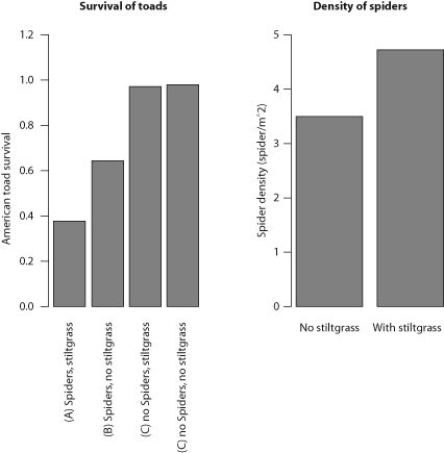Multiple Choice
Japanese stiltgrass is an invasive plant that was accidentally introduced to the United States in the early 1900s. It can be found on roadsides and in forests, and it has many impacts on native plants and animals. Biologists Jayna DeVore and John Maerz studied the effect of Japanese stiltgrass on American toads in their natural habitat. They enclosed American toads in cages with lycosid spiders and/or Japanese stiltgrass. The four treatments were (A) lycosid spiders and Japanese stiltgrass, (B) lycosid spiders without Japanese stiltgrass, (C) lycosid spiders and Japanese stiltgrass, and (D) no lycosid spiders and no Japanese stiltgrass. They compared the survival of American toads across the treatments (left graph) . They also measured the density of lycosid spiders in different areas where Japanese stiltgrass was absent vs. present (right graph) .
 Source: DeVore, J. L., & Maerz, J. C. (2014) . Grass invasion increases top‐down pressure on an amphibian via structurally mediated effects on an intraguild predator. Ecology, 95(7) , 1724-1730.
Source: DeVore, J. L., & Maerz, J. C. (2014) . Grass invasion increases top‐down pressure on an amphibian via structurally mediated effects on an intraguild predator. Ecology, 95(7) , 1724-1730.
-What hypothesis is best supported by these results?
A) Japanese stiltgrass decreases the number of American toads by increasing the amount of habitat available to a predator (lycosid spiders) of American toads.
B) Japanese stiltgrass decreases the number of American toads by reducing the food supply (insects) of the toads.
C) Japanese stiltgrass increases the number of American toads by converting more solar energy to chemical energy than native plants do.
D) Japanese stiltgrass increases the number of American toads by decreasing species diversity of native plants.
Correct Answer:

Verified
Correct Answer:
Verified
Q52: Consider the following marine community: Sea otters
Q53: Dinoflagellates are important to coral and coral-dwelling
Q54: The sum total of a population's use
Q55: A biology student takes fish, algae, pond
Q56: A keystone species that is a predator
Q57: What are the consequences if decomposers are
Q59: In your backyard you overturn a large
Q60: In a food chain consisting of phytoplankton
Q61: Which substance is cycled between organic matter
Q62: The number of species in a community